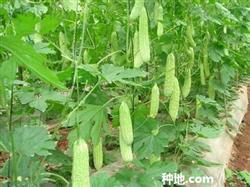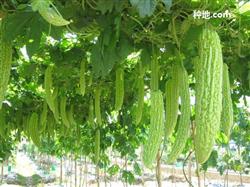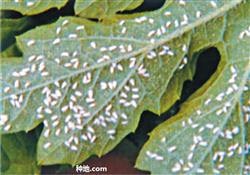How to cultivate balsam pear scientifically?

How to cultivate balsam pear scientifically? Please advise 1. Variety characteristics "Xinxing balsam pear" is a medium-ripe hybrid of Guangzhou Epunong Agricultural Science and Technology Co., Ltd., with trailing plants, strong growth potential and strong branching power, and both main and lateral vines can bear melon. Leaves palm-shaped, green, the first female flower node of the main vine begins to bear female flowers in section 15-20, commercial melon cylindrical shape, fruit length about 30-33cm, transverse diameter 6.5~8cm, melon flesh thick 1.4cm, single melon weight about 600g, melon skin bright green, glossy, tumor strips thick, dense flesh, sweet and crisp taste, good quality, resistance to storage and transportation, at the same time, this variety has good heat resistance, high temperature resistance to 35~38oC, resistance to powdery mildew and beautiful appearance. The merchandise is very good. Second, the seed coat of balsam pear is hard, the seed shell is thick, the surface is waxy, and it is slow and difficult to germinate. Therefore, before seed soaking, it is best to dry the seed in the sun for 3 hours, gently wipe the seed coat wax with wet fine sand, soak the seed in warm water of about 30 degrees for 12 hours, remove and rinse, wipe the skin water, wrap it with clean gauze, put it in an environment of 25mur30 degrees, wash it with warm water every morning and evening, wipe it dry, wrap it and continue to germinate, until most of the seeds are white. Then, after mixing the seeds with 800 times 50% carbendazim wettable powder, the root tips of the seeds are planted downward into the soil of the seedling bag (cup), with the seeds 0.5 cm above the ground. Third, cultivation techniques 1. The medium-ripe variety of "Xinxing balsam pear" was sown on land from February to August, and the nutritive soil was prepared two months before sowing. Nutrient soil formula: vegetable garden soil about 70%, mature soil fertilizer 25%, mature human and animal feces and urine 5%, multi-component compound fertilizer 0.2%, mix well according to proportion, centrally stack, and seal with agricultural film to prevent nutrient loss and ensure full fermentation. 2 weeks before use, add appropriate amount of carbendazim and Lesben solution for disinfection and sterilization, cover with agricultural film and compost for 1 week, then put it into a nutrition bowl with diameter 5cm and high 8cm. Each 667m2 needs nutritious soil about 30Kg, soaking seeds before sowing to accelerate germination. 2. Selecting, preparing and applying basic fertilizer: ① selects the land with deep soil layer, the sandy loam is the best, the clay is the second, and the sandy soil is the worst. ② soil preparation application of basic fertilizer, emerging balsam pear growing prosperous, take a long time, need a large amount of fertilizer. Sufficient organic fertilizer as base fertilizer is the key to strive for high yield. Per 667m2, it is necessary to apply 1500-200kg of mature human and animal manure, refueling 30-35kg, 100kg calcium magnesium phosphate fertilizer, or 20% N, P, K special organic-inorganic fertilizer 150kg, adding potassium sulfate 10kg, calcium magnesium phosphate fertilizer 100kg. When applying base fertilizer combined with soil preparation, the border is made into a high border with a width of 1-1.5m and a height of 25-50cm, and the row spacing between arch shed and flat shed is 3-5m. The basal fertilizer was applied 1-2 weeks before planting, and the planting row was first determined according to the row spacing. The base fertilizer was applied in two shallow trenches on both sides of the 20cm, and then the soil on both sides of the box was made into a high border and covered with plastic film to be planted. 3. Momordica charantia should be ploughed, weeded and cultivated in time from the seedling stage to prevent soil consolidation. Generally, after planting and watering slow seedlings, the first intertillage will be carried out when the topsoil is slightly dry and not sticky. If the soil is too dry or windy, it can be rewatered and then ploughed again. The second intertillage can be carried out 15 days after the first intertillage. This time, attention should be paid to protecting the new roots, which should be shallow rather than deep. Each ploughing can be combined with the application of some high-quality farm fertilizer, such as cake fertilizer, all kinds of poultry feathers and rotten chicken manure, pig manure and so on. After setting up the frame, when the melon vine extends to more than 50 centimeters, the root system is basically covered with the whole row, so it is generally no longer suitable for ploughing. However, attention should be paid to timely pulling out weeds and preventing weeds from growing, so as to improve the ventilation and light transmission conditions in the field and reduce the damage of diseases and insect pests. In the first ploughing, if a lack of seedlings or weak diseased seedlings are found, they should be replanted in time to preserve the seedlings. 4. Scaffolding and pruning when balsam pear seedlings grow to about 20 cm, it is necessary to draw vines. There are two ways to build scaffolding: flat scaffolding and herringbone scaffolding. The flat shed has the advantages of good ventilation, many melons and high yield. Flat scaffolding is divided into multi-span flat scaffolding and sub-span flat scaffolding. The multi-span flat scaffolding is usually in the melon row, with a stake erected every 3 meters, and the stakes of the whole field are connected with small bamboo, small wooden sticks or nylon net, etc., and the roof is about 2 meters from the ground; the split flat scaffolding generally takes every two rows of melons as a shed, with a height of 1.5 meters. The multi-span flat shed has the advantages of large light surface, good ventilation and convenient management, which is better than that of multi-span flat shed. Whether it is multi-span flat scaffolding, or split-span flat scaffolding, or herringbone scaffolding, the scaffolding should strive to be firm, so as to avoid wind collapse, damage to melon seedlings and affect yield. 5. The branching power of balsam pear is very strong, the main vine and lateral vines can bear melon, in general, there is no need for pruning. However, due to the strong growth potential and many lateral vines in winter and spring balsam pear, the lateral vines below 50 cm from the ground and the over-dense and senescent branches and leaves should be removed in time to facilitate ventilation and light transmission and improve the utilization rate of light energy. In the middle of growth, if the vine is too crazy to grow, it is necessary to pick the heart and top in time to inhibit its growth and promote melon knot. The vine of balsam pear should be tied up every 3 days before the seedlings are put on the shed. The method of vine introduction is generally to lead the main vine up along the bamboo, and the side vine to the left and right direction of the bracket. It is appropriate to draw the vine in a sunny afternoon so as not to break it. 6. Topdressing and irrigation balsam pear bear many times, harvest time is long, consumption of water and fertilizer is large. Therefore, fertilizer and water management is an important guarantee for high yield. In addition to the application of sufficient base fertilizer, topdressing is generally applied again in vines, flowering and fruiting, and topdressing at seedling stage can be less. The first topdressing is about 7 days after planting, 10% concentration of mature human feces and urine or 0.5% compound fertilizer and water can be applied, and then applied every 5 times every 7 days, the concentration will gradually increase, and when it blossoms and bears fruit, the concentration of human feces and urine can be increased to about 30%. During the flowering and fruiting period, it is necessary to topdressing 2Mel three times of heavy fertilizer to prolong its harvest period. Generally, in the first flower, 25-30kg cake fertilizer, 15-20kg compound fertilizer and urea 10kg are applied once per mu combined with soil cultivation; after the first harvest, cake fertilizer 20-25kg and compound fertilizer 20kg are applied again, and after each harvest, 30% of human feces and urine or 10-15kg compound fertilizer is applied twice. Topdressing also depends on the weather and leaf color, flexible control, increase or decrease as appropriate. Fourth, pest control: the disease is mainly against downy mildew, Fusarium wilt and leaf spot. Wangke 1500-fold liquid spray can be used to control downy mildew, and 42% suspension spray can be used to control Fusarium wilt and leaf spot. Insect pests mainly control melon fruit flies, thrips, aphids and bugs. Ruidan 3.5% EC 1000-1500 times liquid spray can be used to control melon fruit flies; 20 Shuding 600 times liquid spray can be used to control aphids, thrips and bugs, etc. The pests that are difficult to control are melon fruit fly, melon aphid and melon silk borer. 1. Melon fruit fly: commonly known as "needle wasp", adults lay eggs in melons and fruits, and larvae eat in melon flesh, resulting in melon rot and even fruit drop, seriously affecting the quality and yield of melons. At present, it is the peak period for the emergence of needle wasps, and the comprehensive management methods of pastoral cleaning, trapping and killing adults, insecticides and bagging melons are adopted. It is recommended to use kung fu to kill insects with chemicals. A small bag (5 ml) of Kung Fu on the market can be exchanged for a bucket of water (15 liters). Spraying is carried out before 10-11:00 in the morning or 4-6 in the afternoon during the peak period of adult activity, and the effect is better during the adult mating and spawning period. One of the ways to trap and kill is to use yellow board, yellow cardboard or glue board coated with Vaseline in the vegetable garden, about 20 yuan per mu, which has a better trapping and killing effect on adults. Vigorously popularizing the new technology of bagging and protecting melons can not only reduce the damage of various diseases and insect pests, but also improve the quality and commodity value of melons and fruits. 2. Melon aphid: the adults and nymphs of melon aphids are clustered on the back of leaves, tender stems and shoots to absorb juice. The insect will damage the shoot, the leaf curls, the growing point dies, the leaf shrinks, yellowing and shedding ahead of time, it can also cause soot disease and spread virus disease. Pesticide control recommends 25% Aktai water dispersible granule with high efficiency, broad spectrum, safety and lasting for 21 days, which can effectively control melon aphid and many other pests such as thrips and Liriomyza huidobrensis by using 5000-10000 times. 3. Melon silk borer: the larvae gnaw on the leaves, resulting in perforation or engraving of the leaves, which are often eaten into the melon, affecting the yield and quality. Use 50% curon 1000 times or 2.5% kungfu 1500 times spray every 7-10 days. Fifth, harvest: when the fruit is plump and glossy, the first batch of melons should be harvested in time, usually about 30 days after planting, in order to facilitate the growth of melons and vines behind; after that, they can be harvested every 3-4 days, and can be harvested continuously for 3-5 months. The above cultivation materials are for reference only, and local farmers should choose appropriate cultivation techniques according to the local actual situation. Click to get more balsam pear planting techniques click to get more vegetable planting techniques
- Prev

What do you need to pay attention to in cultivating balsam pear?
What do you need to pay attention to in cultivating balsam pear? Please advise balsam pear is a short-day plant, like temperature, light, heat tolerance, moisture tolerance, not shade tolerance, light length requirements are not strict, longer light is conducive to its good growth, higher requirements for soil moisture and air humidity, but not resistant to waterlogging; wide adaptability, can be in the south of our country.
- Next

How to control whitefly in greenhouse balsam pear?
How to control whitefly in greenhouse balsam pear? Greenhouse whitefly, also known as greenhouse whitefly, belongs to Homoptera, whitefly family. In the late 1970s, with the expansion of greenhouse, plastic greenhouse and other protected vegetables, the occurrence and distribution of this insect showed an expanding trend. At present, it has occurred and damaged in most parts of our country.
Related
- Where is it suitable to grow horseradish in China? it is expected to see the middle altitude horseradish in Alishan.
- How to prevent tomato virus disease reasonably? (Control methods included)
- Many people like to plant towel gourd on the balcony. What are the main points of this method and management?
- What crops can chili peppers be mixed with?
- Fertilization techniques and matters needing attention in Tomato
- What are the grafting techniques for peach seedlings in spring?
- Harm and control methods of root swelling disease of Chinese cabbage
- What are the pests of sweet potatoes? How to prevent and cure it?
- Symptoms, causes and Control methods of navel Rot in Tomato
- The cause of "Cucumber rotten bibcock" in Farmers' planting Cucumber and its Control Plan

